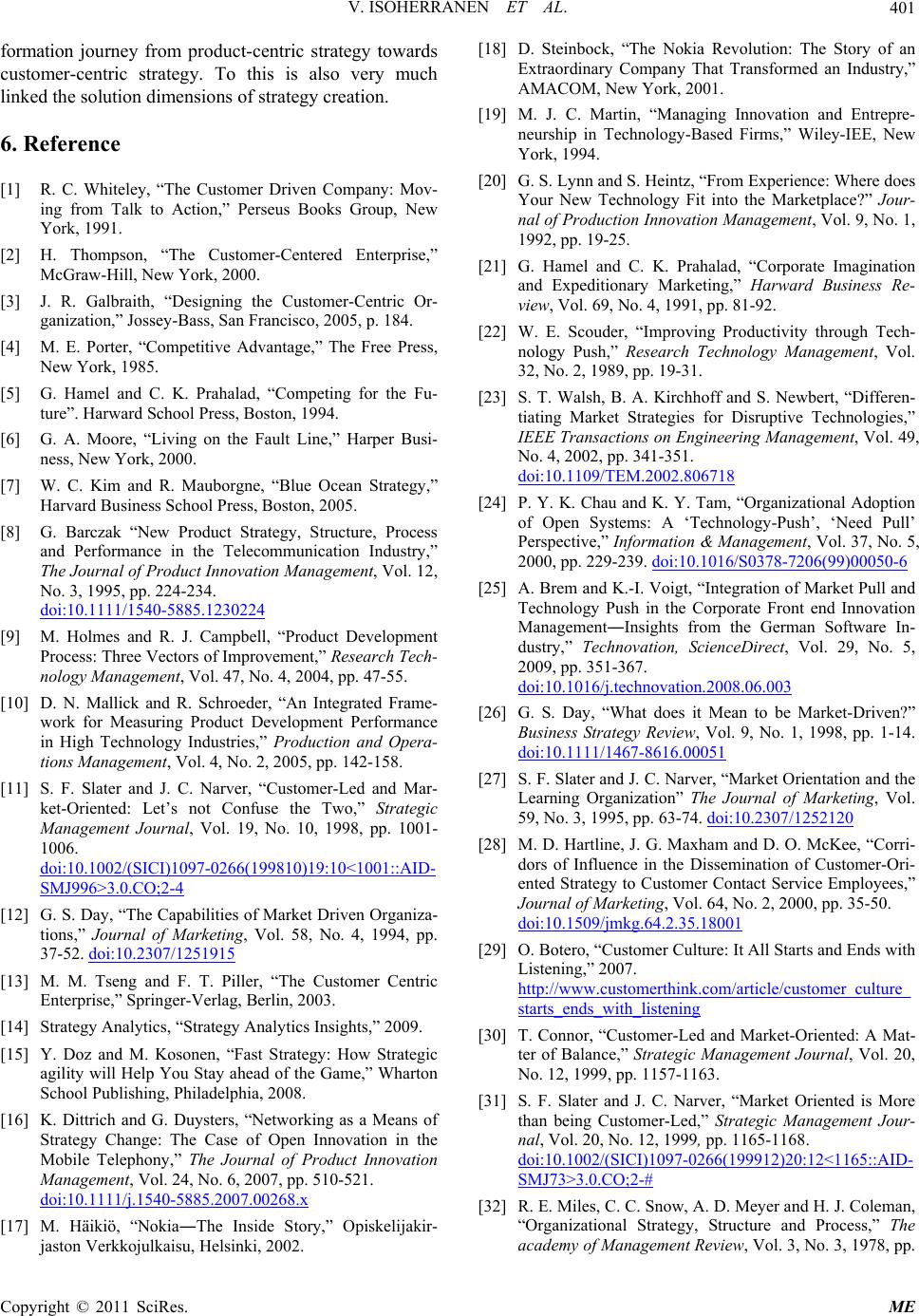
V. ISOHERRANEN ET AL.401
formation journey from product-centric strategy towards
customer-centric strategy. To this is also very much
linked the solution dimensions of strategy creation.
6. Reference
[1] R. C. Whiteley, “The Customer Driven Company: Mov-
ing from Talk to Action,” Perseus Books Group, New
York, 1991.
[2] H. Thompson, “The Customer-Centered Enterprise,”
McGraw-Hill, New York, 2000.
[3] J. R. Galbraith, “Designing the Customer-Centric Or-
ganization,” Jossey-Bass, San Francisco, 2005, p. 184.
[4] M. E. Porter, “Competitive Advantage,” The Free Press,
New York, 1985.
[5] G. Hamel and C. K. Prahalad, “Competing for the Fu-
ture”. Harward School Press, Boston, 1994.
[6] G. A. Moore, “Living on the Fault Line,” Harper Busi-
ness, New York, 2000.
[7] W. C. Kim and R. Mauborgne, “Blue Ocean Strategy,”
Harvard Business School Press, Boston, 2005.
[8] G. Barczak “New Product Strategy, Structure, Process
and Performance in the Telecommunication Industry,”
The Journal of Product Innovation Management, Vol. 12,
No. 3, 1995, pp. 224-234.
doi:10.1111/1540-5885.1230224
[9] M. Holmes and R. J. Campbell, “Product Development
Process: Three Vectors of Improvement,” Research Tech-
nology Management, Vol. 47, No. 4, 2004, pp. 47-55.
[10] D. N. Mallick and R. Schroeder, “An Integrated Frame-
work for Measuring Product Development Performance
in High Technology Industries,” Production and Opera-
tions Management, Vol. 4, No. 2, 2005, pp. 142-158.
[11] S. F. Slater and J. C. Narver, “Customer-Led and Mar-
ket-Oriented: Let’s not Confuse the Two,” Strategic
Management Journal, Vol. 19, No. 10, 1998, pp. 1001-
1006.
doi:10.1002/(SICI)1097-0266(199810)19:10<1001::AID-
SMJ996>3.0.CO;2-4
[12] G. S. Day, “The Capabilities of Market Driven Organiza-
tions,” Journal of Marketing, Vol. 58, No. 4, 1994, pp.
37-52. doi:10.2307/1251915
[13] M. M. Tseng and F. T. Piller, “The Customer Centric
Enterprise,” Springer-Verlag, Berlin, 2003.
[14] Strategy Analytics, “Strategy Analytics Insights,” 2009.
[15] Y. Doz and M. Kosonen, “Fast Strategy: How Strategic
agility will Help You Stay ahead of the Game,” Wharton
School Publishing, Philadelphia, 2008.
[16] K. Dittrich and G. Duysters, “Networking as a Means of
Strategy Change: The Case of Open Innovation in the
Mobile Telephony,” The Journal of Product Innovation
Management, Vol. 24, No. 6, 2007, pp. 510-521.
doi:10.1111/j.1540-5885.2007.00268.x
[17] M. Häikiö, “Nokia―The Inside Story,” Opiskelijakir-
jaston Verkkojulkaisu, Helsinki, 2002.
[18] D. Steinbock, “The Nokia Revolution: The Story of an
Extraordinary Company That Transformed an Industry,”
AMACOM, New York, 2001.
[19] M. J. C. Martin, “Managing Innovation and Entrepre-
neurship in Technology-Based Firms,” Wiley-IEE, New
York, 1994.
[20] G. S. Lynn and S. Heintz, “From Experience: Where does
Your New Technology Fit into the Marketplace?” Jour-
nal of Production Innovation Management, Vol. 9, No. 1,
1992, pp. 19-25.
[21] G. Hamel and C. K. Prahalad, “Corporate Imagination
and Expeditionary Marketing,” Harward Business Re-
view, Vol. 69, No. 4, 1991, pp. 81-92.
[22] W. E. Scouder, “Improving Productivity through Tech-
nology Push,” Research Technology Management, Vol.
32, No. 2, 1989, pp. 19-31.
[23] S. T. Walsh, B. A. Kirchhoff and S. Newbert, “Differen-
tiating Market Strategies for Disruptive Technologies,”
IEEE Transactions on Engineering Management, Vol. 49,
No. 4, 2002, pp. 341-351.
doi:10.1109/TEM.2002.806718
[24] P. Y. K. Chau and K. Y. Tam, “Organizational Adoption
of Open Systems: A ‘Technology-Push’, ‘Need Pull’
Perspective,” Information & Management, Vol. 37, No. 5,
2000, pp. 229-239. doi:10.1016/S0378-7206(99)00050-6
[25] A. Brem and K.-I. Voigt, “Integration of Market Pull and
Technology Push in the Corporate Front end Innovation
Management―Insights from the German Software In-
dustry,” Technovation, ScienceDirect, Vol. 29, No. 5,
2009, pp. 351-367.
doi:10.1016/j.technovation.2008.06.003
[26] G. S. Day, “What does it Mean to be Market-Driven?”
Business Strategy Review, Vol. 9, No. 1, 1998, pp. 1-14.
doi:10.1111/1467-8616.00051
[27] S. F. Slater and J. C. Narver, “Market Orientation and the
Learning Organization” The Journal of Marketing, Vol.
59, No. 3, 1995, pp. 63-74. doi:10.2307/1252120
[28] M. D. Hartline, J. G. Maxham and D. O. McKee, “Corri-
dors of Influence in the Dissemination of Customer-Ori-
ented Strategy to Customer Contact Service Employees,”
Journal of Marketing, Vol. 64, No. 2, 2000, pp. 35-50.
doi:10.1509/jmkg.64.2.35.18001
[29] O. Botero, “Customer Culture: It All Starts and Ends with
Listening,” 2007.
http://www.customerthink.com/article/customer_culture_
starts_ends_with_listening
[30] T. Connor, “Customer-Led and Market-Oriented: A Mat-
ter of Balance,” Strategic Management Journal, Vol. 20,
No. 12, 1999, pp. 1157-1163.
[31] S. F. Slater and J. C. Narver, “Market Oriented is More
than being Customer-Led,” Strategic Management Jour-
nal, Vol. 20, No. 12, 1999, pp. 1165-1168.
doi:10.1002/(SICI)1097-0266(199912)20:12<1165::AID-
SMJ73>3.0.CO;2-#
[32] R. E. Miles, C. C. Snow, A. D. Meyer and H. J. Coleman,
“Organizational Strategy, Structure and Process,” The
academy of Management Review, Vol. 3, No. 3, 1978, pp.
Copyright © 2011 SciRes. ME